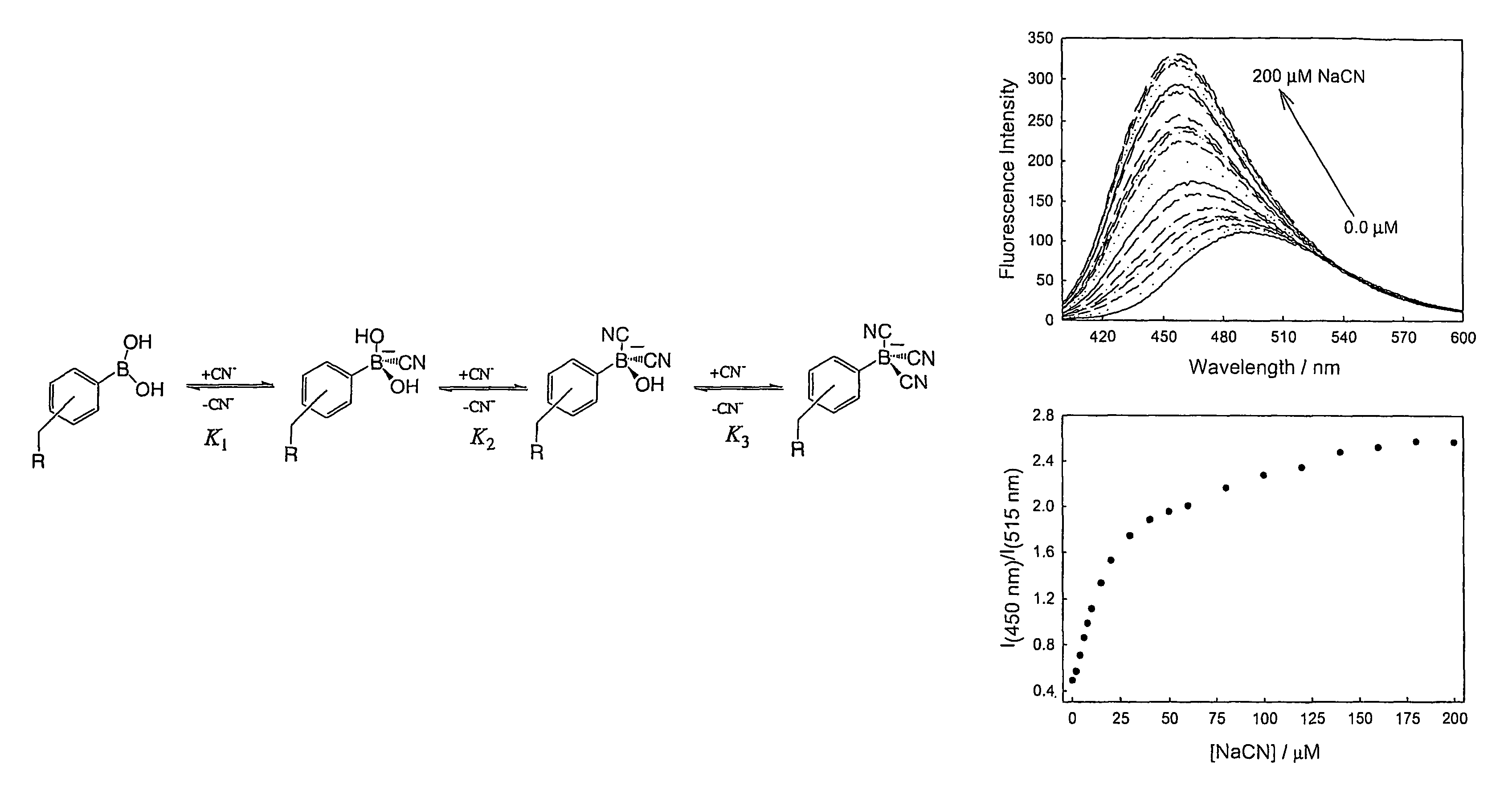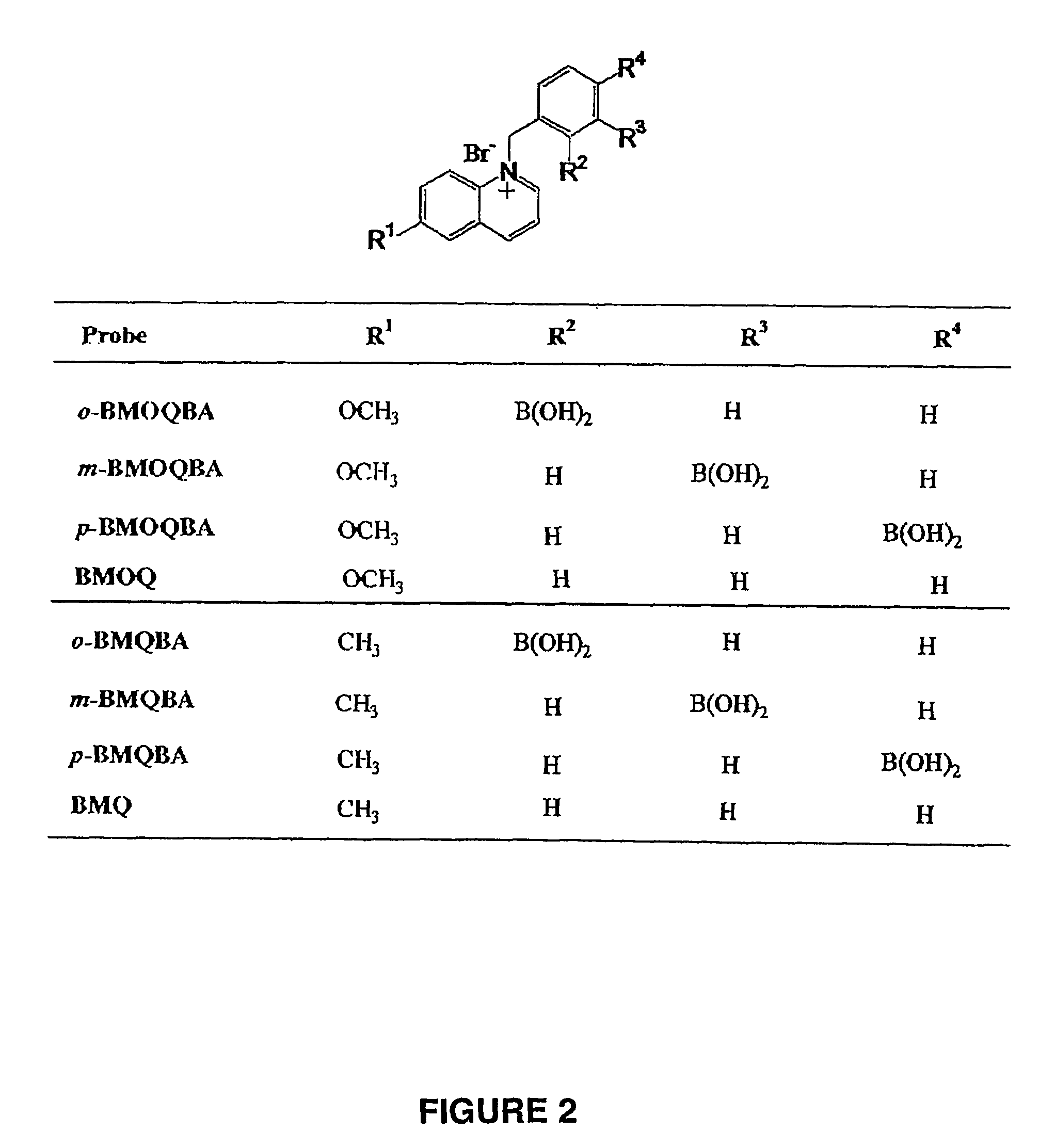Cyanide sensing compounds and uses thereof
a technology of cyanide and sensing compounds, applied in the field of detection, determination, and quantification of cyanide compounds, can solve the problems of inability to reliably measure fluorescence intensity away from the laboratory, the system of most of these systems is not cheap, portable or field deployable, and the cyanide poisoning is not common. achieve the effect of high affinity for a cyanide compound
- Summary
- Abstract
- Description
- Claims
- Application Information
AI Technical Summary
Benefits of technology
Problems solved by technology
Method used
Image
Examples
example 1
[0084]Fluorescence spectra were collected on a Varian eclipse spectrofluorometer with solution optical densities less than 0.2 and λex=345 and 320 nm for BMOQBA and BMQBA, respectively.
[0085]Stability (Ks-units uM−3 or mol−3 dm9 for CN− and mM−1 or mol−1 dm3 for glucose and fructose) and Dissociation constants (KD) were obtained by fitting the titration curves with aqueous sodium cyanide to the relation:
[0086]I=Imin+ImaxKs[cyanide]1+Ks[cyanide](1)
where Imin and Imax are the initial (no cyanide) and final (plateau) fluorescence intensities of the titration curves, where KD=(1 / KS).
[0087]Time-resolved intensity decays were measured using reverse start-stop time-correlated single-photon counting (TCSPC) [31] with a Becker and Hicki gmbh 630 SPC PC card and an un-amplifed MCP-PMT. Vertically polarized excitation at 372 run was obtained using a pulsed LED source (1 MHz repetition rate) and a sheet polarizer. The instrumental response function was ≈1.1 ns fwhm. The emission was collecte...
example 2
[0114]Molecular structure of ortho-, meta-, and para-BAQBA probes and the control compound BAQ, which does not contain the boronic acid moiety are shown in FIG. 12.
[0115]All solution absorption measurements were performed in a 4×1×1-cm quartz cuvette (Starna), using a Cary 50 spectrophotometer from Varian. Fluorescence spectra were similarly collected on a Varian Eclipse spectrofluorometer with solution optical densities less than 0.2 and λex=358 nm. Stability, dissociation constants (KD), mean lifetime, intensity decay were determined as set forth in Example 1.
[0116]FIGS. 13A and B show the absorbance for both o-BAQBA and BAQ with increasing cyanide concentrations, respectively. As the cyanide concentration increases the absorption band at 388 nm decreases while the band at 340 nm increases. Notably, significant changes in both bands can be seen as the cyanide concentration is increased (FIG. 13A). As expected the absorption spectrum of BAQ is unchanged by the addition of cyanide, ...
example 3
[0125]To show the generic application of the boronic acid moiety to cyanide sensing, several different mechanisms were chosen, which have been previously used to induce spectral changes in the presence of sugar. In particular dyes were used that showed excited-state charge transfer (CT) [37, 36, 35 and 46], photo-induced electron transfer (PET) [49] and a probe based on a resonance interaction (RI) [47]. The fluorescent probes, as shown in FIG. 22, were prepared as previously reported [37, 36, 35, 47, 48 and 49].
[0126]FIG. 22 shows two stilbene derivatives that contain the boronic acid moiety. DSTBA, 4′-dimethylaminostilbene-4-boronic acid, which combines the electron-donating dimethylamino group with the electron-withdrawing boronic acid group and CSTBA, 4′-cyanostilbene-4-boronic acid, which combines the electron-withdrawing cyano group with boronic acid.
[0127]FIG. 23A shows the fluorescence emission spectra of DSTBA with increasing concentrations of aqueous cyanide. The emission ...
PUM
| Property | Measurement | Unit |
|---|---|---|
| emission wavelength | aaaaa | aaaaa |
| emission wavelength | aaaaa | aaaaa |
| optical densities | aaaaa | aaaaa |
Abstract
Description
Claims
Application Information
 Login to View More
Login to View More - R&D
- Intellectual Property
- Life Sciences
- Materials
- Tech Scout
- Unparalleled Data Quality
- Higher Quality Content
- 60% Fewer Hallucinations
Browse by: Latest US Patents, China's latest patents, Technical Efficacy Thesaurus, Application Domain, Technology Topic, Popular Technical Reports.
© 2025 PatSnap. All rights reserved.Legal|Privacy policy|Modern Slavery Act Transparency Statement|Sitemap|About US| Contact US: help@patsnap.com



